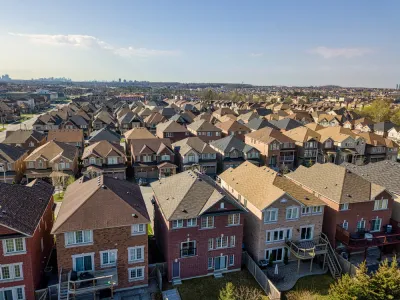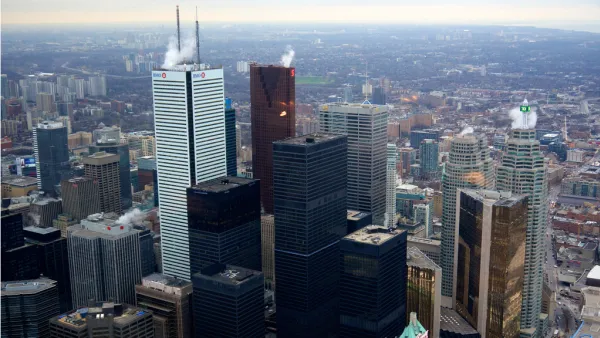The architecture critic for the Globe and Mail finds fault with two massive development proposals in the Toronto suburbs.

Alex Bozikovic, architecture critic for the Globe and Mail, writes about what he calls "a bit of Hong Kong in the 905"—the conceptual renderings for two new 'transit-oriented communities' in the Toronto suburbs of Richmond Hill and Markham.
"Drawings show forests of shimmering, skinny towers dropped into a flat suburban landscape," according to Bozikovic (see the renderings at the source article), and some local residents see a 'wasteland.'
While acknowledging the decidedly NIMBYesque flavor of the local opposition, Bozikovic writes "But in this rare instance, they’re right."
Bozikovic offers that frank assessment while also acknowledging the sound logic behind the proposal: "Put people near transit, and they will take transit rather than drive. And when you put enough people together, they can support retail and other amenities within walking distance."
So what goes wrong with the current proposal? According to Bozikovic the plan stretches that logic "to absurdity."
The High-Tech site would include 33 towers with 21,000 homes, plus retail and enough offices for about 7,000 jobs. One single block there would include three towers of 60 storeys and three of 80 storeys. The Bridge plan is comparable. Parks are thin. There are no schools. This would be one of the densest clusters of development in the entire region.
Bozikovic wrote an article in February 2020 that repeats similarities on the theme of how challenging it can be to build an urban suburb from scratch—and there are examples in the Toronto region, in Bozikovic's opinion, of failed attempts.
FULL STORY: With Doug Ford’s development plans for Toronto suburbs, sometimes big is too big

National Parks Layoffs Will Cause Communities to Lose Billions
Thousands of essential park workers were laid off this week, just before the busy spring break season.

Retro-silient?: America’s First “Eco-burb,” The Woodlands Turns 50
A master-planned community north of Houston offers lessons on green infrastructure and resilient design, but falls short of its founder’s lofty affordability and walkability goals.

Delivering for America Plan Will Downgrade Mail Service in at Least 49.5 Percent of Zip Codes
Republican and Democrat lawmakers criticize the plan for its disproportionate negative impact on rural communities.

Test News Post 1
This is a summary

Test News Headline 46
Test for the image on the front page.

Balancing Bombs and Butterflies: How the National Guard Protects a Rare Species
The National Guard at Fort Indiantown Gap uses GIS technology and land management strategies to balance military training with conservation efforts, ensuring the survival of the rare eastern regal fritillary butterfly.
Urban Design for Planners 1: Software Tools
This six-course series explores essential urban design concepts using open source software and equips planners with the tools they need to participate fully in the urban design process.
Planning for Universal Design
Learn the tools for implementing Universal Design in planning regulations.
EMC Planning Group, Inc.
Planetizen
Planetizen
Mpact (formerly Rail~Volution)
Great Falls Development Authority, Inc.
HUDs Office of Policy Development and Research
NYU Wagner Graduate School of Public Service





























